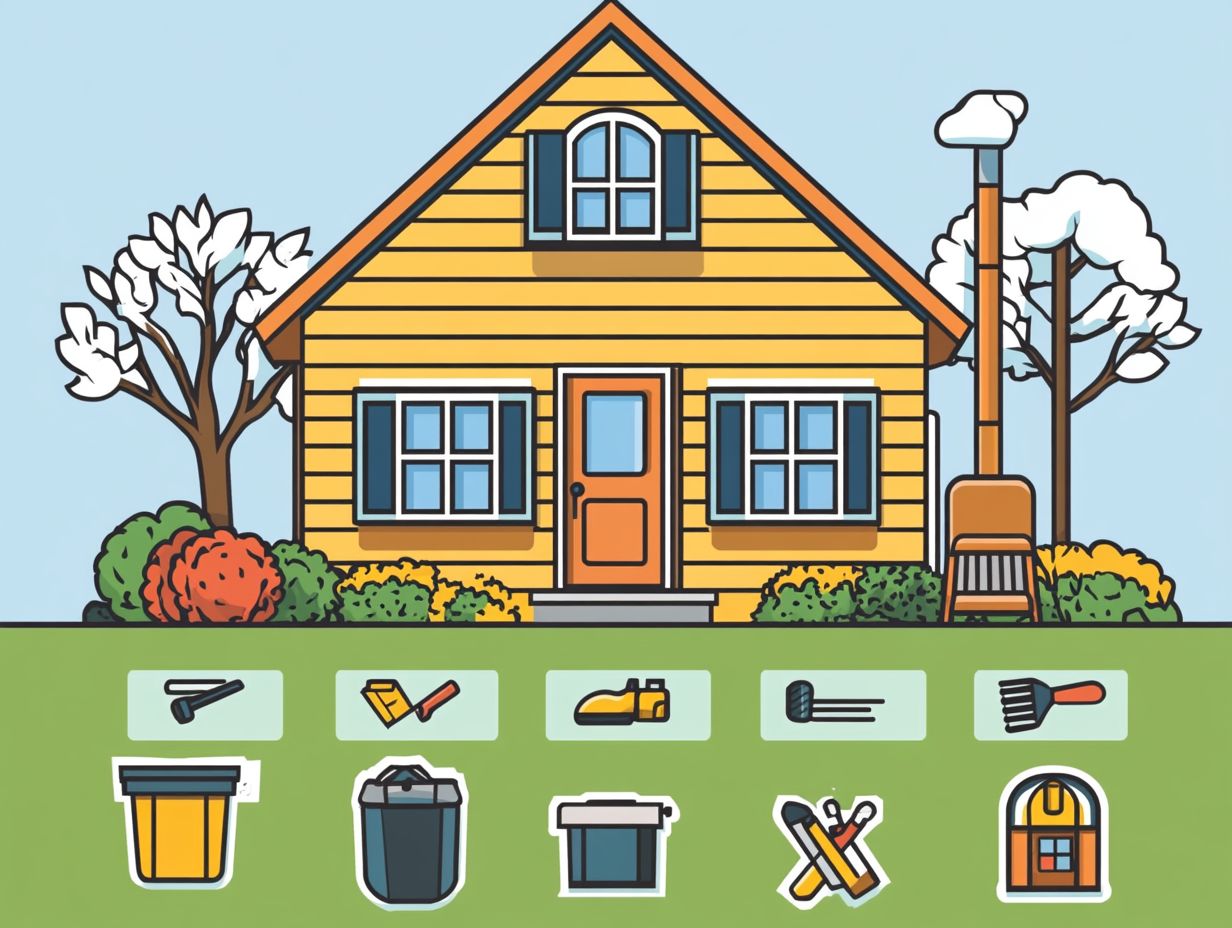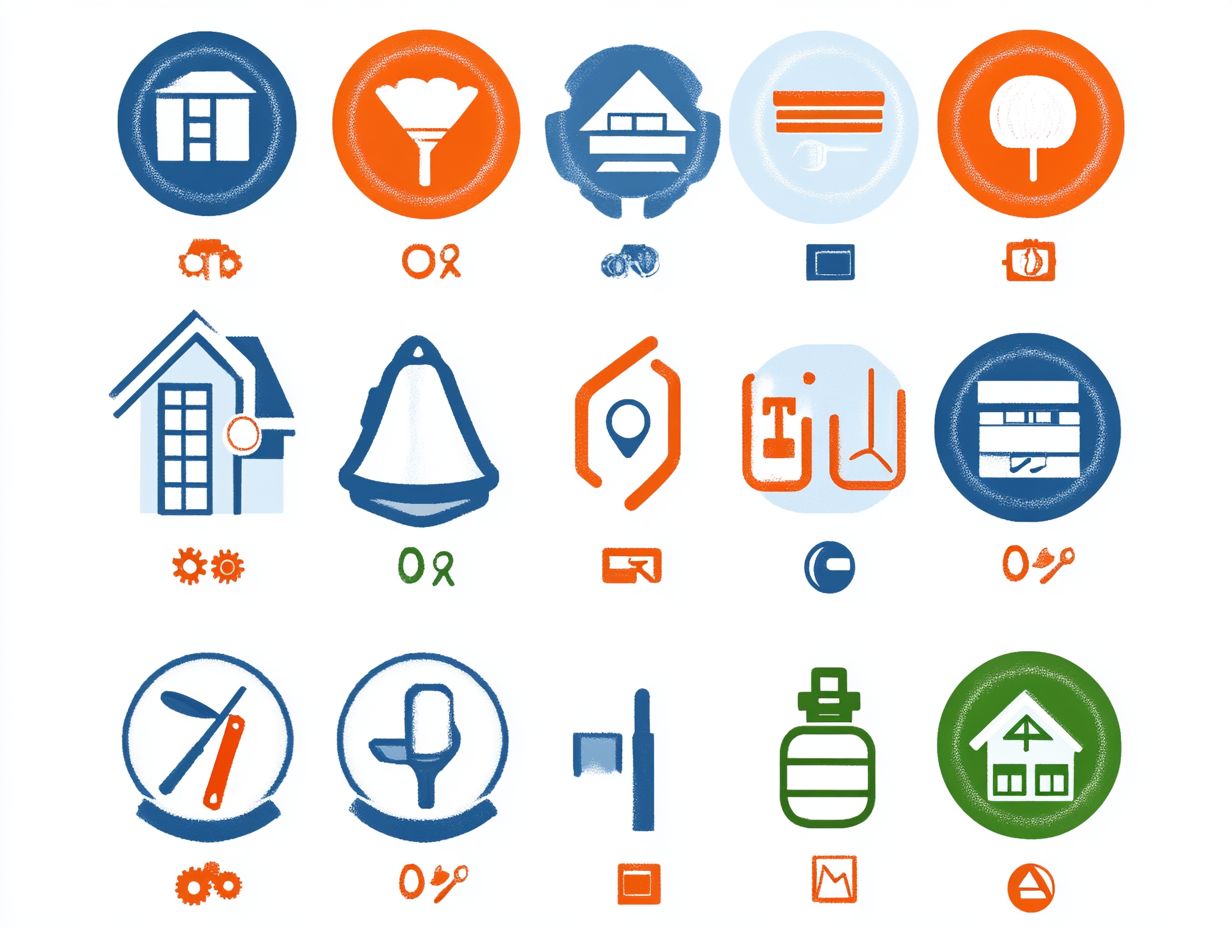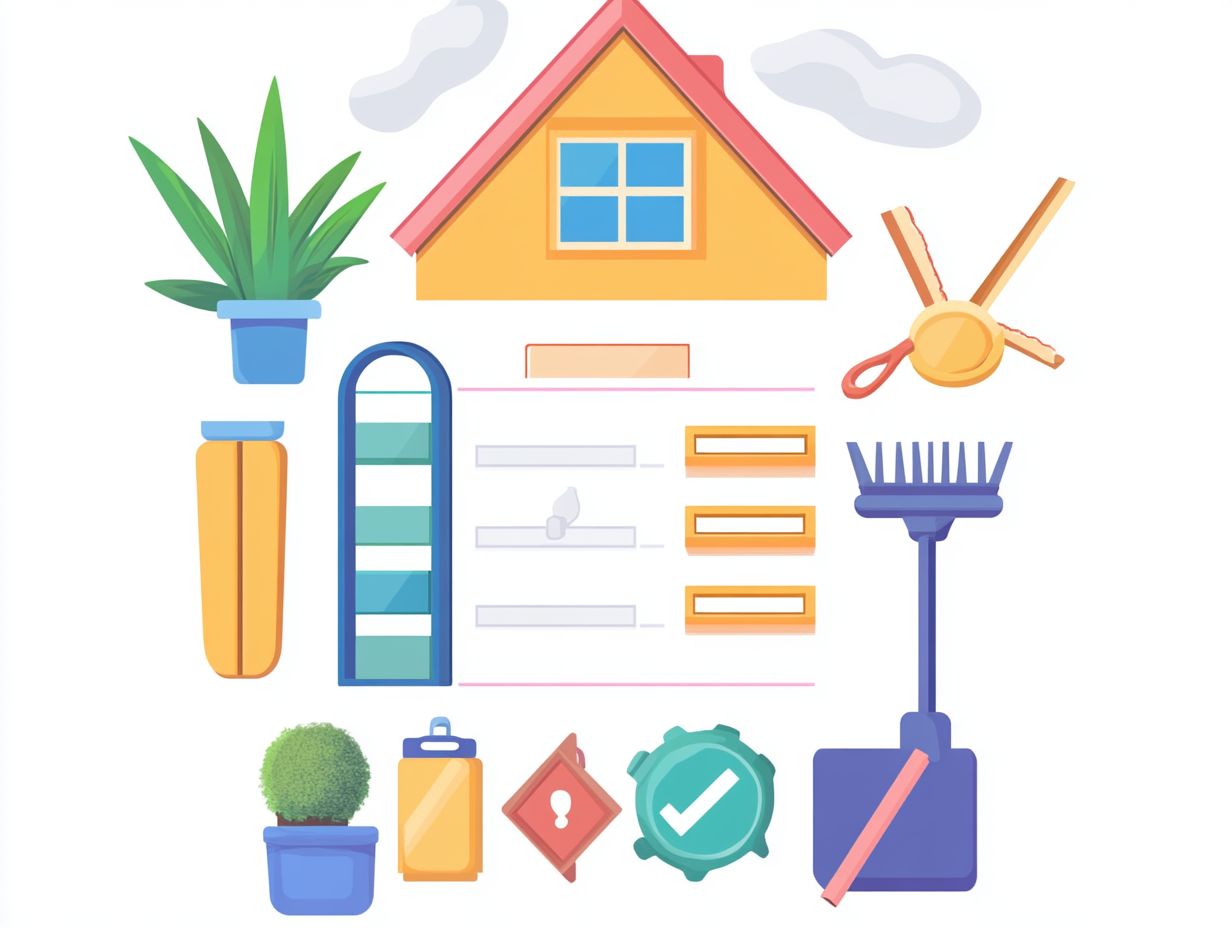Seasonal maintenance, including spring maintenance, summer maintenance, fall maintenance, and winter maintenance, is essential for keeping your home in excellent condition and ensuring its longevity. Each season presents specific tasks that can help prevent costly repairs and enhance your home’s efficiency. These tasks encompass home maintenance activities such as home inspection, property upkeep, and routine inspections.
This guide offers important checklists for spring, summer, fall, and winter, highlighting the essential jobs to be completed in each season. Additionally, it includes year-round maintenance tips to help you stay on top of these tasks and create a safe, comfortable living environment for you and your family. Proper seasonal tasks and home care tips ensure that your home remains in top-notch condition throughout the year.
Why is Seasonal Maintenance Important?

Seasonal maintenance is essential for protecting the integrity of your home through regular upkeep of necessary repairs, as well as seasonal checks and controls that ensure the property remains safe, functional, and visually appealing throughout the year.
One significant benefit of seasonal maintenance is that it often enhances energy efficiency, leading to reduced utility bills. This process includes checking insulation, sealing leaks, and servicing heating and cooling systems, such as your HVAC system, all of which contribute to lower energy consumption.
Plus improving energy efficiency, regular maintenance can increase a home’s market value, making it more attractive to potential buyers while enhancing the owner’s pride and comfort. Tasks such as landscaping, property management, and curb appeal improvements are essential to maintaining and boosting home value.
Furthermore, seasonal maintenance can bolster emergency preparedness and disaster response plans. Having a strategy in place for seasonal storms or extreme weather conditions can alleviate anxiety and protect your investment. This includes having emergency repairs ready and ensuring home safety with regular safety checks and home security measures.
Lastly, by establishing a consistent schedule for repairs and inspections, seasonal maintenance helps homeowners manage the complexities of homeownership effectively. A well-planned maintenance schedule ensures that tasks like roof maintenance, plumbing inspections, and HVAC system servicing are done timely, contributing to the overall upkeep and safety of your home.
Spring Home Maintenance Checklist
A comprehensive spring home maintenance checklist is essential for ensuring that homes are thoroughly inspected and maintained after winter and before summer. This spring maintenance guide covers essential tasks including home inspection, home repairs, and garden preparation to ensure your property is in optimal condition.
Spring is an ideal time for homeowners to conduct deep inspections and cleanings, which should include safety checks for the HVAC system, gutter cleaning, and addressing any pest control issues that may have arisen during the winter months.
Additionally, spring maintenance and cleaning enhance curb appeal and prepare gardens and lawns for growth and use. Tasks such as fertilizing, lawn care, and irrigation setup are crucial to ensure a thriving outdoor environment.
Tasks to Tackle in the Spring

The changing weather patterns of spring make it an ideal time for homeowners to undertake a variety of essential tasks, such as HVAC maintenance, roof inspections, and gutter cleaning. By addressing these seasonal tasks, homeowners can prevent future problems and ensure their homes are well-maintained. Spring cleaning and humidity control help improve indoor air quality, while outdoor maintenance activities like gardening, landscaping, and irrigation enhance the overall appearance of the home.
Other important spring tasks include:
- Inspecting plumbing and electrical systems: Identifying and addressing issues with plumbing and electrical systems early can prevent larger problems that may lead to costly repairs in the future.
- Checking smoke detectors and carbon monoxide detectors: Regularly testing alarms, changing batteries, and cleaning detectors are crucial to ensuring they function properly.
- Clearing debris around the foundation: Cleaning gutters, downspouts, and drains of leaves and other debris prevents flooding and ensures proper drainage away from the foundation. This practice reduces the likelihood of mold growth, which is common in spring due to increased rainfall.
- Inspecting windows and doors for leaks: Air leaks around your home can lead to significant energy waste, especially in spring when temperatures transition from cold to warm. Moreover, pests often seek out cracks and leaks, so sealing these areas helps maintain a safe and comfortable living environment during the spring months.
Summer Home Maintenance Checklist
A comprehensive summer maintenance checklist is essential for maintaining a safe and efficient home throughout the hot summer months. This summer maintenance checklist ensures that everything, from HVAC systems to outdoor spaces, is in proper working order.
Homeowners should prioritize preventive maintenance tasks that focus on energy efficiency, protection against weather-related damage, and preparation for potential heat-related issues. Regular inspections of the home can uncover any existing problems, while tasks such as lawn care, exterior cleaning, and outdoor maintenance can enhance your home’s curb appeal and overall value.
Keeping Your Home in Top Shape During the Summer

To maintain your home during the summer, focus on cleaning the exterior, caring for your lawn, and controlling pests. Summer maintenance tips for your home’s exterior are crucial for keeping it in peak condition as temperatures rise and to prevent potential damage from severe weather conditions.
Proper lawn care not only enhances the aesthetic appeal of your property but also contributes to environmental sustainability. Additionally, staying vigilant against pests with pest control and pest prevention measures can help prevent infestations that could damage your home during the warmer months.
Homeowners may also consider adding regular inspections of decks and patios to their summer maintenance checklist. This practice can help identify areas of wear and tear that need attention. Summer is also the ideal time for deck maintenance, window cleaning, and gutter cleaning, ensuring that water flows freely during summer storms.
Implementing effective pest control strategies, such as sealing cracks, minimizing debris around your home, and using natural repellents, can help mitigate infestations. Organization is key; decluttering outdoor spaces makes them more inviting and ensures easy access for any necessary repairs. Effective storage solutions and home organization strategies can enhance both indoor and outdoor living spaces.
If issues arise, knowing that home repair services are available can alleviate concerns, whether related to maintenance or repairs. Engaging in DIY maintenance or seeking professional services ensures that your home remains in optimal condition.
Fall Home Maintenance Checklist
Fall maintenance is a crucial time for homeowners to adhere to a comprehensive checklist to prepare their homes for winter. This fall maintenance involves autumn home maintenance tasks such as roof inspections, gutter cleaning, and implementing weatherproofing measures to protect against severe winter weather. Home safety inspections and routine inspections are essential to prepare the home for the colder months.
By completing these seasonal maintenance tasks in advance, homeowners can prevent costly repairs and ensure the longevity and safety of their homes. Tasks such as interior painting, exterior painting, and pressure washing can also help maintain the home’s aesthetics and functionality.
Preparing for the Colder Months

Preparing for the colder months requires proactive home maintenance, which includes tasks such as cleaning gutters, inspecting or installing insulation, and cleaning the chimney. For homeowners, winter preparation is a crucial priority to ensure that their homes and properties remain safe and efficient during the freezing months. Proper snow removal and drainage systems setup are essential for maintaining home safety during winter.
Conducting safety checks, such as testing electrical fire alarms and verifying the battery life of smoke detectors, is essential in preventing emergencies and enhancing overall home safety during winter. Additionally, scheduling seasonal inspections, including home safety inspections and property inspections, with a trusted home repair service can help identify potential issues that may arise as outdoor temperatures drop.
This may involve assessing the efficiency of the furnace, sealing drafts around windows and doors, and testing plumbing for vulnerabilities that could lead to freezing. Having an emergency preparedness plan in place, which includes stocking emergency kits with essentials like batteries and blankets, is critical for saving lives during intense winter storms. Seasonal upgrades and maintenance schedule adherence can also ensure preparedness for winter weather.
These measures not only maintain the integrity of the home but also contribute to the peace of mind of everyone living there. Home security and property enhancements are also vital to ensuring that your home remains a safe haven during winter.
Winter Home Maintenance Checklist
Winter presents unique challenges for homeowners, making a comprehensive winter home maintenance checklist essential. This winter maintenance checklist should cover critical tasks such as HVAC maintenance and plumbing inspections to prevent freezing pipes and ensure comfort.
Homeowners must take proactive steps to protect their properties from weather-related maintenance issues, including insulating vulnerable areas and conducting regular system checks to maintain optimal energy efficiency. Engaging in preventive maintenance during the winter can significantly reduce repair costs while enhancing the safety and functionality of your home. This includes tasks like thermal insulation and weatherproofing measures.
Protecting Your Home from Winter Weather
The most effective ways to protect your home from winter weather include proper weatherproofing and thorough inspections. Insulating your property and checking your roof are essential steps to ensure your home can withstand winter’s harshest conditions. Proper home repair skills and home improvement tasks like foundation checks are also critical.
Additionally, emergency preparedness measures, such as assembling a winter storm kit and developing a maintenance plan to address potential issues before they arise, should be top priorities for homeowners. Implementing these measures not only helps protect your home but also enhances overall safety and comfort during the winter months. Regular home energy audits and seasonal repairs are also recommended.
Organizing your living spaces can further increase winter home safety by decluttering areas that are prone to slips and falls and ensuring that pathways remain clear. It is also wise to review existing home warranties, as many cover damage from winter storms, offering homeowners extra peace of mind. Proper home organization and storage solutions are critical during the winter months.
Finally, changing seasonal decor and using weather-resistant materials can enhance the beauty of your home while reducing the risk of damage from winter storms or freezing temperatures. Effective seasonal cleaning and seasonal inspections ensure your home remains in top shape.
Year-Round Maintenance Tips and Home Care Tips
Year-round maintenance is crucial for maintaining the structural integrity and comfort of a home. It involves a well-planned maintenance schedule and adherence to a comprehensive home maintenance checklist. Homeowners should regularly update their seasonal checklists and acquire the necessary tools and maintenance supplies to carry out various tasks throughout the year, including spring, summer, fall, and winter maintenance. Effective year-round home maintenance not only keeps properties in good condition but can also save homeowners thousands of dollars in long-term expenses.
A Home Maintenance Guide serves as a valuable tool for year-round upkeep, helping with the development of a home maintenance schedule and providing checklists for seasonal tasks such as spring maintenance and fall maintenance. This ongoing maintenance ensures regular attention to the home throughout the different seasons by following a clearly laid-out schedule that adheres to a thorough checklist. The best home maintenance schedules are created by consistently updating seasonal checklists.
Year-round maintenance encompasses acquiring essential tools and supplies, as well as timing tasks appropriately throughout the year. Taking a proactive approach to home maintenance helps homeowners avoid costly repairs in the long run. Benefits of year-round maintenance extend beyond cost savings and include:
- Improved Home Safety: Regular checks of roofs and gutters, testing smoke detectors, and inspecting HVAC systems contribute to a safer living environment.
- Enhanced Home Value: Consistent cleaning and upkeep of bathrooms, kitchens, carpets, and yards enhance curb appeal and prevent expensive replacements or repairs.
- Shortened Repair Time: Routine maintenance allows homeowners to identify minor repairs before they escalate into costly issues; for instance, addressing a leaking faucet promptly can prevent a hefty water bill.
- Healthier Living Environment: Regular maintenance of HVAC systems and thorough cleaning of carpets and yards helps reduce allergens, which is especially important for families with children or elderly members.
- Improved Energy Efficiency: Consistent attention to the maintenance and cleaning of HVAC systems, windows, and other energy-related components of the home boosts their performance and efficiency.
- Increased Property Upkeep: Regular lawn care, landscaping, and pest control are essential for maintaining the exterior of the home.
An example of an effective home maintenance guide is the yearly home maintenance calendar from Family Handyman. This calendar outlines important tasks to complete throughout the year, including specific seasonal tasks:
- January: Check the attic for signs of roof leaks, and clear gutters and downspouts. Perform roof maintenance if necessary.
- February: Flush the water heater, remove debris from the patio, and check and test carbon monoxide detectors.
- March: Clean bathroom vents and fans, and check smoke detectors. Begin garden preparation and fertilizing.
- April: Clean the fireplace, inspect the roof and chimney, and clean the bathroom exhaust fan.
- May: Check and tune up the air conditioning. Also, start regular irrigation and lawn care routines.
- June: Clean windows and screens, and check smoke alarms.
- July: Clean refrigerator condenser coils and check for signs of termites. Address any pest prevention needs.
- August: Inspect insulation in the basement and crawl space. Perform seasonal pest control and check for mold prevention.
- September: Check the furnace, clean vents, and check smoke detectors. Begin preparing the home for winter maintenance tasks.
- October: Winterize outdoor faucets and inspect doors, windows, and vents for drafts. Ensure proper weatherproofing and thermal insulation.
- November: Clean gutters and downspouts, and check the sump pump. Perform home safety inspections and emergency preparedness checks.
- December: Check thermostats and smoke detectors, and store holiday lights and decorations. Conduct routine inspections and maintenance of HVAC systems.
By following this structured approach, homeowners can ensure their properties remain safe, efficient, and well-maintained year-round, encompassing both outdoor maintenance and indoor maintenance tasks.
Tasks to Keep Up with Throughout the Year: A Seasonal Checklist
Homeowners should regularly perform essential maintenance tasks to ensure their homes function properly. These tasks include regular lawn care, appliance servicing, and ongoing home inspections. Additionally, seasonal inspections and property inspections can help maintain home value and curb appeal throughout the year.
Keeping detailed maintenance records and conducting regular checks enables homeowners to monitor the condition of their homes and address any issues early on. Proactively engaging in home repair services, including emergency repairs and routine inspections, not only enhances the longevity of the home but also helps preserve its overall value and comfort.
Routine maintenance ensures that minor problems are identified before they escalate into significant issues that require costly repairs. For instance, tasks like gutter cleaning and HVAC service checks help prevent water damage and ensure that heating and cooling systems operate efficiently. Other important tasks include plumbing inspections, electrical systems checks, and maintaining insulation and ventilation systems for improved energy efficiency.
Additionally, local community support services can provide valuable resources, such as workshops on home maintenance and access to reliable contractors, including those specialized in home repairs, appliance repairs, and property management. These resources further assist homeowners in maintaining their properties and fostering a stronger, safer community.


